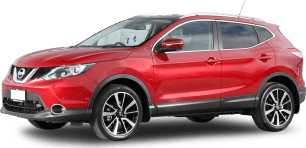The Qashqai is one of the better-looking small SUVs, and the N-Sport ups the visual ante in just the right places.
Up front, it is disappointingly equipped with halogen headlights, but at least they’re capped off by arrow-shaped LED daytime running lights (DRLs). The fog lights also use cheaper bulbs, which don’t make for great night-time visibility.
Anyway, the design itself is attractive, with Nissan’s signature 'V-Motion' grille large and in charge, featuring a mesh insert and a combination of gloss-black and chrome trim.
The N-Sport stands out from the Qashqai crowd with its body-colour front bumper, which features matte-silver inserts across the side air intakes.
Around the side, the wheelarches are also body-colour, with unique 19-inch 'Wind' alloy wheels positioned below. Their multi-spoke design certainly spices things up.
Again, the N-Sport turns to a matte-silver finish, this time for the Qashqai’s side-mirror caps, roof rails and skirts. It’s all subtle but effective.
At the rear, the N-Sport’s tailgate spoiler and arrow-shaped LED tail-lights are lifted from other members of the Qashqai family, so no surprises there.
But look lower and another body-colour bumper with matte-silver inserts comes into view. And if you’re still having a hard time picking the difference, there’s also the obligatory ‘N-Sport’ badge to really spell things out.
Inside, the N-Sport looks like any other Qashqai, save for its black cloth/leather-accented seat upholstery and black headliner.
So, there’s not much in the way of ‘innovation that excites’, especially where the 7.0-inch touchscreen is concerned. A recent update introduced a new multimedia system, which goes some way in making up for the sins of its predecessor.
That said, it’s still one of the worst out there due to its lack of functionality, low resolution and puzzling widescreen format. Thankfully, Android Auto and Apple CarPlay support is now on hand, so make the most of it.
The multi-function display wedged in between the traditional tachometer and speedometer is good, though, serving up all the right information to the driver.
And then there's the interior’s seriously premium quality. While the leather-accented steering wheel and gear selector are to be expected, the soft-touch upper and passenger-side middle dashboard, and front door shoulders are not.
So too are the leather-accented armrests, door inserts, door handles and knee rests. It’s all very nice. The same can’t be said, though, for the centre stack’s gloss-black trim, which is prone to annoying fingerprints. The titanium accents used elsewhere are less troublesome.






.png)
















































.png)
























 copy.png)
















